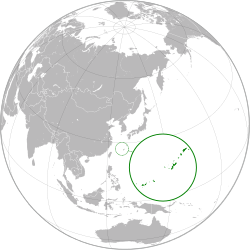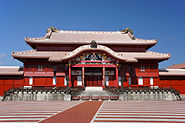Ryukyu Kingdom 琉球國 Ruuchuu-kuku | |||||||||||||||||
|---|---|---|---|---|---|---|---|---|---|---|---|---|---|---|---|---|---|
| 1429–1879 | |||||||||||||||||
| Anthem: Ishinagu no Uta[1] | |||||||||||||||||
Royal seal: | |||||||||||||||||
 The Ryukyu Kingdom at its maximum extent (present-day Okinawa Prefecture and the Amami Islands) | |||||||||||||||||
| Status |
| ||||||||||||||||
| Capital | Shuri | ||||||||||||||||
| Common languages | Ryukyuan languages (indigenous), Classical Chinese, Classical Japanese | ||||||||||||||||
| Religion | Ryukyuan religion (State Religion), Shinto, Buddhism, Confucianism, Taoism | ||||||||||||||||
| Demonym(s) | Ryukyuan | ||||||||||||||||
| Government | Monarchy | ||||||||||||||||
| King (國王) | |||||||||||||||||
• 1429–1439 | Shō Hashi | ||||||||||||||||
• 1477–1526 | Shō Shin | ||||||||||||||||
• 1587–1620 | Shō Nei | ||||||||||||||||
• 1848–1879 | Shō Tai | ||||||||||||||||
| Sessei (摂政) | |||||||||||||||||
• 1666–1673 | Shō Shōken | ||||||||||||||||
| Regent (國師) | |||||||||||||||||
• 1751–1752 | Sai On | ||||||||||||||||
| Legislature | Shuri cabinet (首里王府), Sanshikan (三司官) | ||||||||||||||||
| History | |||||||||||||||||
• Unification | 1429 | ||||||||||||||||
| 5 April 1609 | |||||||||||||||||
• Reorganized into Ryukyu Domain | 1872 | ||||||||||||||||
| 27 March 1879 | |||||||||||||||||
| Currency | Ryukyuan, Chinese, and Japanese mon coins[3] | ||||||||||||||||
| |||||||||||||||||
| Today part of | Japan | ||||||||||||||||
| History of Ryukyu |
|---|
  |
The Ryukyu Kingdom[a] was a kingdom in the Ryukyu Islands from 1429 to 1879. It was ruled as a tributary state of imperial Ming China by the Ryukyuan monarchy, who unified Okinawa Island to end the Sanzan period, and extended the kingdom to the Amami Islands and Sakishima Islands. The Ryukyu Kingdom played a central role in the maritime trade networks of medieval East Asia and Southeast Asia despite its small size. The Ryukyu Kingdom became a vassal state of the Satsuma Domain of Japan after the invasion of Ryukyu in 1609 but retained de jure independence until it was transformed into the Ryukyu Domain by the Empire of Japan in 1872.[b] The Ryukyu Kingdom was formally annexed and dissolved by Japan in 1879 to form Okinawa Prefecture, and the Ryukyuan monarchy was integrated into the new Japanese nobility.
- ^ Seisai Tokuchi『日本文学から見た琉歌概論』(Musashinoshoin、1972),299-300
- ^ Kikō, Nishizato. "明清交替期の中琉日関係再考" (PDF) (in Japanese). pp. 23–25. Archived from the original (PDF) on 18 February 2022. Retrieved 17 May 2021.
- ^ "Ryuukyuuan coins". Luke Roberts at the Department of History – University of California at Santa Barbara. 24 October 2003. Archived from the original on 4 August 2017. Retrieved 1 June 2017.
- ^ "琉球国金石文献述略" (in Chinese). Ancient History Institute of the Chinese Academy of Social Sciences. 25 December 2018.
- ^ a b c "旧条約彙纂. 第3巻(朝鮮・琉球)" (in Japanese). National Diet Library. Retrieved 20 April 2021.
Cite error: There are <ref group=lower-alpha> tags or {{efn}} templates on this page, but the references will not show without a {{reflist|group=lower-alpha}} template or {{notelist}} template (see the help page).

